“Start by doing what’s necessary; then do what’s possible; and suddenly you are doing the impossible.”—St. Francis of Assisi.
If somebody had told me that one day I would be able to comfortably swing the 48kg Beast for 100 reps of one-handed swings in five minutes at a bodyweight of 68kg, I would have told him he was crazy. But lo and behold, I can do exactly this today, and I got here much faster than I expected—and without hurrying.
And that is not all. I pulled close to 2.5 times my bodyweight in the deadlift without having trained the deadlift, pressed half my bodyweight without pressing, hit a bent press personal record without bent pressing, owned a snatch test without snatching, and kept reasonable strength in many other exercises that I did not practice at all.
All I did was follow one simple program—a Simple & Sinister program.
This is my In-Between Simple & Sinister story, so please read on.
Why Did I Start Simple & Sinister?
A year ago, after I finished my barbell Power To The People! program, successfully fulfilling a goal of pulling 2.5-times bodyweight in the deadlift, and after lots of traveling and teaching both at home and abroad, I decided to jump on Simple & Sinister (S&S). My original plan was to own the Simple goals, and then see what to do next. I thought of S&S as a kind of short-term transitional program.
Because I am basically never out of shape, to reach and “own” the Simple goals took me a relatively short time. After only a month and a half, maybe two, I did the 100 one-arm swings in five minutes and five get-ups per arm in ten minutes with the 32kg kettlebell. Once I accomplished that, I thought, “Well, why switch to something else? I enjoy the simplicity of the program and I feel great, so let’s continue.” So I set my sights on the Sinister goal of using the 48kg kettlebell—aka “The Beast.”
Six months after I started S&S, I did my first set of one-arm swings with the Beast and the first set of get-ups with 40kg. In April, I did all 100 swings with 48, and after a year of consistent practice, I am very near to meeting the Sinister goal in get-ups as well.
Here are my thoughts, tips, and tricks from my training diary. You will learn some subtle, but very important details regarding the particular S&S drills. I will point out certain aspects of S&S program that are often overlooked, but which are key to your long-term improvement. And I will also share a few “WTH” moments regarding the transfer of swings and get-ups to other modalities and exercises.
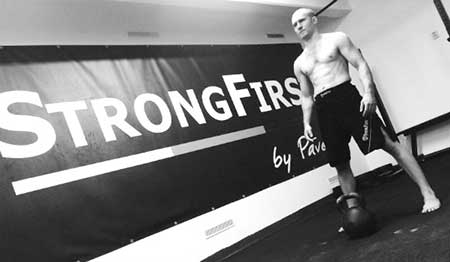
S&S Warm-Up and Movement Prep
Pavel writes in S&S, “Keep your warm-ups short,” and has recommended on the forum that after few months you can skip halos and SFG hip bridges, but you should keep the prying goblet squats. Based on my experience, I am in total agreement with this.
When your shoulders are fine, your overhead position in the get-up perfect, you have woken up sleeping glutes, and you have a crisp swing lockout, you may skip the halo and StrongFirst hip bridge, and just do them when you feel like it (I still do them from time to time). Keep the prying goblet squat.
- Kettlebell Halo is a simple, but effective drill for loosening up the shoulders, but there is more. When I practice the halo, I also practice the correct lockout as well—straight knees, tight glutes, braced abs. Apart from loosening and strengthening the shoulders (this is a weighted mobility drill, after all) I think the halo also helps me keep my elbows healthy. When you start to do heavy swings and get-ups, you will need it.
- StrongFirst Hip Bridge wakes up the glutes and opens up tight hips. They are much needed after prolonged periods of sitting. If you have a desk job, don’t skip them. The hips play a crucial role not only in the swing, but also in the get-up. When my hips are tight, my get-ups don’t feel right, so before the get-ups I sometimes do few roll to elbow naked get-ups.
- Prying Goblet Squat is The Squat, period. Pavel said at our SFB Certification, “Not everybody needs to squat heavy, but everybody needs to squat. And the goblet squat is the squat for the people.” I treat S&S as my “SFG Big Three“— goblet squat, swing, and get-up—and never skip them in my practice. Also, make sure to read Jason Marshall’s “3 Squat Tips: Understanding Squat Cues.”
Tips on the S&S Kettlebell Swing
Most people do the swing incorrectly because they think it is a two-count movement. This is how it’s usually demonstrated on YouTube University:
- 1 (down) = evading to soon, which leads to all kind of troubles like the weight pulling you forward, ending too low between the legs, etc.
- 2 (up) = lifting with the hands.
Wrong. Think of the swing as four-count movement. Let’s start from the top:
- 1—Bell is falling, you wait in the plank.
- 2—You evade and hinge when the arms touch the body and the bell almost hits you in the groin.
- 3—You explosively reverse the movement and come back to plank.
- 4—Bell flies forward.
1-2-3-4, 1-2-3-4, 1-2-3-4…
Steve Freides, StrongFirst Certified Senior Instructor has commented:
“I describe this, your steps #2 and #3, as a quick turn-around. In order to affect a quick turn-around, you must wait as long as possible before moving your hips back and then, as quickly as you sent them back, you must bring them forward again. Except for the quick turn-around, the rest of the time is float.”
I take this coaching to heart and have been working on quickly reversing the bottom position of the swing. When I hit the right spot (not sooner and not later), I can produce much more force. Plyometrics without jumping, you say? Yes.
Additional swing tips:
- Make sure you sit deep in your hinge! The hinge is the foundation for kettlebell deadlift, which in turn is a foundation for a proper swing. Dr. Michael Hartle, StrongFirst Certified Master Instructor, told me whenever he runs into problems with the swing or deadlift, he often prescribes the simple hip hinge pattern and the following homework: multiple sets of ten, throughout the day. It works like a magic. When you come back to the swing, you will see a huge improvement in the range of motion and quality of movement.
- When swinging a heavier bell, maintain the plank. Lean back at your ankles at the top of the swing, not at your back. It won’t be a vertical plank anymore, but it still needs to be the plank.
Special Notes on Rest Periods Between Sets
Many students, brainwashed by the do-or-die HIIT mentality, don’t read the S&S book properly, and try to hit the five-minute test limit every single session. This approach might work for a short time, but then the person will quickly hit the wall.
Al Ciampa wrote on the StrongFirst forum, “If you are constantly testing your abilities, you are no longer ‘training.’” Which means, you are no longer improving. The fact that the swings are in the beginning of the S&S training session should tell you what qualities to focus on: strength and power! Don’t worry, you will get the conditioning you are after.
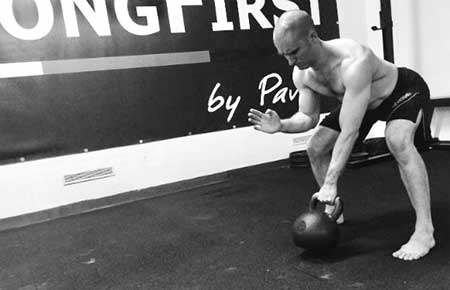
During my regular S&S practice, I always give myself plenty of rest—more than I feel I need. I do Fast & Loose drills and breath recovery drills. I walk around and focus on the upcoming set. A relatively long rest period allows me to do an absolutely explosive set of ten hard style swings with a “one punch, one kill” mentality. I only time my rest periods during the test days, and I don’t “try” to hit the standard (100 hard style swings in 5 minutes). I am 100% sure I can do it, so I just do it.
The results of this strategy? In addition to the desired conditioning effect, I experience more strength and power, and less soreness. On my fortieth birthday, exactly one year after I started S&S, I did 40 consecutive one-arm swings with the Beast. The session looked like this: 20 with my left, switch, 20 with my right, set down, celebration dance.
S&S swing protocol is a foreshadowing of the exciting anti-glycolytic training Pavel is working on. Make sure to follow his advice to the letter:
“Most of your S&S sessions do not rush the clock and wait until you can pass the talk test before your next set. On the last session of each week push harder and occasionally all out and test yourself.”
After only few months into S&S, I put a note in my training diary:
“I am amazed by very fast improvement in swing—the weight is light; swings are crisp and explosive. One-hand swings with 48 seemed like some mythical feat (for light guy like me), now I am sure I can get there. Sooner or later, but yes… I am surprised how well it’s going. I guess that it is because you improve your swings by doing swings—daily. Not too many, or not enough, but ‘minimum effective dose.’”
You might progress faster or slower, but it doesn’t matter. As Brett Jones, StrongFirst’s Director of Education says: keep swinging.
Tips on the S&S Kettlebell Get-Up
Old time strongman Sid Harmer wrote of the get-up in his Feats of Strength: “It is a feat which requires not only strength, but small amount of balance and pluck. I have found that it is a stunt of which most strong men are almost afraid.”
Not us in StrongFirst. We love get-ups. But there are some basics you will need to remember on your S&S journey:
- Grip: Experiment with the grip—deeper, less deep, wiggle your hand, grip. Trust me, there is a sweet spot for your hand and your kettlebell. If you find out in the roll to press phase that your grip feels weird, re-adjust or return the kettlebell to the floor and start all over. Check out an excellent tip from Brett Jones.
- Setup: Packing the shoulder of the kettlebell hand after you grab the kettlebell on the floor and during the roll before the floor press makes the floor press and the roll to elbow much more stable and easier. Try to pack your kettlebell hand shoulder to the opposite hip.
- Roll to Elbow: We all know we have to point the bent knee slightly in and drive hard through the heel of the bent leg. With a relatively heavy kettlebell, I point the arm with the kettlebell in the same direction—of course not too much, otherwise I could lose the kettlebell—and voila, smooth transition without the common leg lift. Think of the center of gravity of a heavier kettlebell. The heavier the kettlebell is, the more you have to “wedge” under it, and the less perpendicular your arm will be. Another good way to learn the mechanics of this transition is to focus on the movement on the way down.
- Tall Sit: Focus on this position on the way down. Many students bend the elbow of the supporting hand on their way down.
- Low Sweep: Many students do a cross-over of low sweep, high bridge, and a squat, which results in awkward and jerky transition. Practice this phase a lot, without a kettlebell. Divide the low sweep into two moves: first, tuck in the straight leg, and second, swing it back, brushing the floor with your shin. It is called a low sweep for a reason. Sweep the floor with your shin. Same on the way down—sweep your bent leg forward, touching the floor with your shin, and sit down as soon as possible. Only then extend the bent leg. Make sure the non-kettlebell hand stays locked to give you better support during the transition.
- Lunge to Standing: Before standing up from the lunge position, I adjust my front leg a little bit in. Standing up becomes much easier. On the way down, I adjust the front foot a little bit out before the (reverse) windshield wiper. It might not apply to everybody, but this adjustment suits my body type (i.e. the length of my lower limbs). Experiment, of course, without a kettlebell.
- Get Down: Don’t hurry. You will unlock many of the transitions on the way down. Indeed, many of the old timers practiced the get-up as get-down/get-up. If you rush the get-ups, you can’t “steer” the weight. Take your time, do every single transition with patience, and stop at every stage.
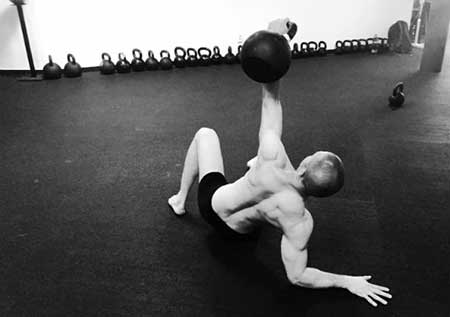
The S&S Program and the Element of Practice
Two keywords for your practice are κάλλος (kállos, “beauty”) and σθένος (sthénos, “strength”). Perform your exercises like somebody is watching and giving you points, with absolute focus on perfect technique, like you are being judged at the SFG Certification by a Team Leader. The reward won’t be applause or a certificate, but better technique, skill, health, and strength. And that is what matters.
“Years ago, my friend Dr. Jim Wright said something that got burned into my brain: ‘Consistency and moderation over intensity.’ Not nearly as sexy as “Do or die!” or some other juvenile T-shirt slogan, but you could not think of a better set of directions for durable performance.”—Pavel and Dan John, Easy Strength
S&S is a form of constant practice, i.e. multiple sets with the same weight, or a kind of a step cycle. You spend some time with your current weights, and when you really own them, you add one set with a heavier weight. Pavel has noted on the forum:
“Remember that S&S is designed for you to do in a manner of ‘I can do it again tomorrow with the same level of energy and the day after tomorrow.’”
With that in mind, here are my thoughts on going heavier and going easier.
How to Incorporate a Heavier Kettlebell
With a light kettlebell, you can swing incorrectly. With a heavier kettlebell, you can’t as the kettlebell will teach you. In the swing, a heavy kettlebell will pull you forward, it will drop down rather than back, and it will not fly chest high if you are lazy with your hinge.
In a get-up, it’s a different story. The technique of a get-up with 24kg and 44kg is quite different, because the center of mass has shifted. Most people will encounter problems with the roll to elbow phase. With a heavier kettlebell, try the following:
- With a kettlebell that is relatively heavy for your bodyweight, the arm with the kettlebell will not be perpendicular to the floor. If you try to do so, you will either lose the kettlebell or your straight leg will kick up when you roll. Shift the kettlebell slightly to the direction where your free hand and extended leg is pointing.
- Don’t do a sit-up (we all know this). Dig that heel hard into the floor, lift your glute first, point the bent knee slightly in, and roll. Make sure the foot of the bent leg stays flat on the floor.
- Wedge underneath the kettlebell when you finish the roll to elbow. The best way to find out how to do it is to the reverse the movement, and do it slowly.
Are you scared of a heavier kettlebell? Try this. Just get familiar with it (“Hello, 48. I am Pavel!”), doesn’t matter how. Deadlift it, do a few partial get-ups with it (even just roll to press), grab it and carry it to the other side of the gym, or push press it and hold in a overhead position. Slowly get used to it, and you won’t be afraid of it when the time comes to do [fill in the blank] with the kettlebell. When you mistakenly grab 36 instead of 32, it is a good sign. When you get stronger, big kettlebells start to shrink.
When you train with a new, heavier kettlebell, it will feel challenging, but it shouldn’t feel very heavy. When the previously heavy weight starts to feel lighter, you are getting stronger. When the old weight feels relatively light, the new weight doesn’t feel heavy.
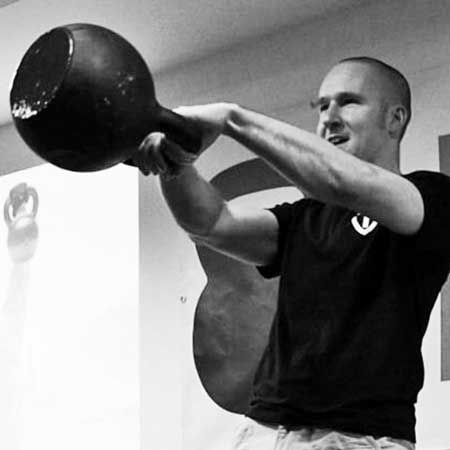
Easy Days Option
I enjoy working on my deload days with lighter weight, doing things like overspeed eccentric swings and static-dynamic get-ups. I feel these were a great help, and in my opinion, this is one of the secret ingredients of S&S—the ingredient many people miss.
Ten-second pauses in lighter get-ups will teach you something about alignment, it will help you to identify the left-right asymmetries, optimize the structure, improve smooth transition from perfect point A to perfect point B, and exercise your patience.
I usually do the two-hand overspeed eccentric swings when I feel tired. I did them with 24, but it started to feel really light, so I now usually do them with 32. Symmetrical movement, lighter, extra focus on explosiveness.
The common problem at the bottom of the two-hand swing is collapsing of the chest inward. When you focus on “opening” the chest (i.e. trying to do the opposite of what the kettlebell wants to do), you will keep your shoulders in a better position, plus you will work some back muscles you didn’t even know you had. For some reason, they work my rhomboids very well.
I would like to emphasize again: the “light day” option in S&S is, in my opinion, one of the “secrets” of the program. Many practitioners tend to forget about this S&S option, but it is one of the keys to success, especially when you get to heavier weights. Do it. Pavel is right: ”Do not turn an off-day into a day off. Easy training is far better than no training.”
Solid: In-Between Simple & Sinister Transfer, or the WTH Effect
The most frequently asked question I received during my S&S training was, “So, you are only doing get-ups and swings. How about military press, deadlift, etc.?” People like to say that if you practice only such minimalistic programs, you must get significantly weaker in other lifts that you don’t practice at all, right? Maybe not.
Of course, as it has been said on many occasions, the SAID principle typically applies to our training. SAID stands for “specific adaptation to imposed demand.” Said simply, you get better at what you practice. But we all know about kettlebells are famous for their WTH effect.
So, after about six months of S&S training, I decided to run a few tests on this phenomenon myself, and here are the results:
Kettlebell
- Half-bodyweight+ military press (one of the requirements for passing the SFG II), 36kg (my previous 1RM)—Easy.
- Bent press, 48kg—New PR! My previous 1RM was 40kg.
- Kettlebell snatch test, 100 reps in 5 minutes with 24kg—Check. No grip issues at all. I did: 20-20,15-15, 10-10, rest, 5-5, finish. I could definitely do 25-25, 30-30, or even more in the first set. It was not easy, but not hard. Heavy swings definitely help a lot. Of course, don’t forget SAID—if you are preparing for a snatch test, you have to snatch. Brett Jones’ snatch protocol from SFG Level I Prep Guide is the way to go.
Barbell
- Deadlift—160 kg, which is 5kg below 2.5x bodyweight in the deadlift and very close to my 1RM of 165kg.
Bodyweight
Karen Smith, StrongFirst Certified Master Instructor happened to be conducting special research for a new project, so I gave her test a shot. The task: 5×5 pistols and 5×5 one-arm pushups (OAPU). These were performed to strict SFB standard and for time, measuring the work-to-rest ratio.
Result: 16 minutes 20 seconds, all sets completed, no failure. Pistols were quite easy, but pushups were harder, especially the last sets. Note: In addition to my S&S training, I have been doing pistols and OAPU once a week for a few reps just to check my symmetry (or the lack of it), as recommended at the SFB Certification.
Apart from that I also tested the following:
- Strict handstand pushups max—14 HSPU. It should be noted that though I learned the technique of HSPUs, I have never practiced them.
- Strict tactical pullups—16 reps. My all-time max is 24, but that was after a specialized pullup program.
Bragging about the numbers isn’t the point, the numbers are not very impressive, but I kept quite a lot of my strength in the lifts I don’t practice at all, just by doing S&S, and approaching S&S as a skill (of strength) practice.
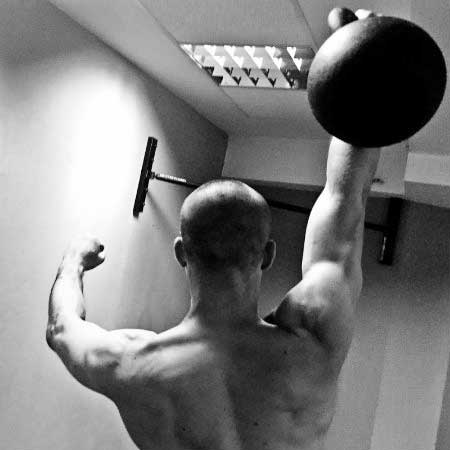
S&S FAQs
99% of the questions I get asked can be solved with a simple answer: “Read the book. Again.”
I will give you an answer for the other 1% of the questions:
Q: “Can I [change this, substitute that, modify that, or… ]?”
A: “Until you reach at least ‘Simple’ standards, no.”
Closing Remarks
Steve Freides, Senior SFG, wrote on StrongFirst forum:
“The brilliance of Pavel’s simple programs lies in their simplicity. It’s hard enough for a coach to design an effective program for a student—hard enough but within the abilities of a sizable group of people on our planet. But the ability to design a program that is also simple while still remaining effective, and on top of that, is also applicable to a very wide range—well, that is truly exceptional. Simplicity increases adherence and, in the end, yields more progress for more people.”
I could not have written it better.
The skills and values we learn in the gym have positive transfer to real life outside the gym. That is why it is called functional training. Doing the same exercises for an extended period of time might lead to boredom—or to technical proficiency, finesse, strength, and health. I chose the second option.
Everybody will progress at a different rate. Take your time, don’t rush, don’t compare yourself with others, patiently work on the skill of strength, and own at least the Simple goals, and you will be doing better than ever before.
I didn’t come this far to only come this far. The way to achieving Sinister is simple: repeat until strong!
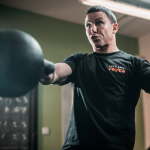


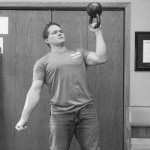
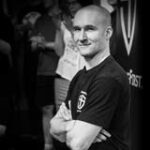






Sounds like near daily s&s training is key. But how many days a week do you go heavier versus lighter? For example i can OHS the 44 for 100 reps in about 7min and do only 1 TGU set with 44, 3 sets using the 40 and last set 32 -takes about 12-14min. Which bells should i be using for heavy day and lighter day?
Thanks a lot.
Brent,
– you should not rush your sets during training, only once a while during testing
– you should use only 2 weights – I your get-up case I suggest 32 and 40 and get really proficient there
– the light day option (two-hand overspeed eccentric swings and get-ups with 10 sec stops, both with light bell) should be used when you are sore or tired
– occasionally – when really sore and tired – skip the session, and have extra nap and steak
Thank you! Working better w 32 and 40.
I notice on one arm swings you and some other advanced people end on the “float” w the dorsum of the wrist, with the wrist in slight flexion? Is there an advantage to having the wrist slightly flexed? I keep my wrist straight (neutral) and the bell swings a little up on the float.
Thank you!
Brent, in the swing, focus of projecting the force forward.
Thank you for the mention of swaying slightly back at the ankles. I found an awesome groove that allows me to get a deep hip hinge. However on the up swing I knew I was swaying g back but it “felt” right. But I was under the assumption you had to be in a straight up plank. This has helped tremendously for my back and everything feeling solid and crisp on the swings!! I noticed that what I was doing was cushioning the down fall and not properly addressing my grip so now my grip is playing catch-up. Thank you and it’s right when they say your body will compensate for weak points.
I am glad that the video helped. Keep swinging, and report how it goes!
When I do get ups more than twice per week I get a hot spot on my right elbow. If I do the S&S work 4 or 5 days a week my elbow will start bleeding then I need to take some time off for it to heal. Do you think I should cover my elbow (wear a long sleeve shirt) or is there something you think I may be doing wrong?
Mark, I have never heard of an elbow bleeding. It would be interesting to see what exactly is happening there. (There should be no twisting, etc.) BUT, yes, just covering your elbow seems like an easy fix. Maybe cut the toe off a tube sock, if a long sleeve shirt isn’t optimal.
Thanks Nikki.
thank you. the S&S book was clear, but your comments and videos have been really helpful in clarifying specifics of execution. I feel confident that the daily sub-maximal exercise routine will avoid injury (I was making great progress with other routines – Body for Life, German Volume Training – until blown spinal disks and knee meniscii brought things to a crashing stop), and allow my 55+ frame to make continued progress! thank you for the clear and helpful videos and commentary.
:->
Thank you Bill, I am glad you find the article and videos useful. All the best in your S&S practice!
Hello Pavel,
after I’ve read this article, I started since January 2017 (again) my journey in S&S only. It fits well with it’s lower amount of time needed, because I’ve got a new job and need more concentration on it.
Last year I followed different C&P protocols from StrongFirst and got my 36 kg Press, 32 kg doublepresss x 3 and a DL of 145 kg weighing 79-80 kg.
My goal is to reach the simple goal first. Than I’ll see, what my old joints will say.
Where I’m now and which kind of advice I need:
I’m 44 years old and need some help with programming. At the moment I’m able to hit the test with a 28 kg KB BUT with double handed swing! My PR in TGU is 36 kg, with a 32 kg I can do 5 TGUs a side, but not in 10 min. 100 dh swings in 5 min with a 32 kg KB are also nor a problem. Somehow I feel my oh swing much less explosive and definitely not good enough for 5 sets of 20 reps done on minute. S&S training 3-4 times a week, switching between 24 kg on easy days to 32-36kg on the heavier ones.
How can I make my oh swing better?
Thanks and best regards from Düsseldorf to wonderful Prague!
Sergej
Sergej, S&S puts emphasis on one-hand swing. Use a lighter weight, and build up from there.
I have a question about the 100 reps in 5 minute goal. Do you still take rest period, and keep heart rate under 180-minus-age? Or do you take rest but disregard heart rate? Or do you go all out with no rest and no heart rate measurement?
When not trying for the goal, you would rest every 10 reps to keep heart rate under 180-minus-age, correct?
Thank you for clarifying.
Brad, I do not use a HR monitor.
During my regular practice, I just take as much rest as I need – a minute, two, three – as much as I need, and few dozens seconds extra.
During the test, I just do it – 10 swings, shake it out, 10 swings, shake it out, on minute.
Pavel,
Your swing and get up videos were very helpful. I was reluctant to do the get ups because the first time I tried them with a 24 kg kettlebell I rolled down too quickly and the kettlebell started coming down towards my face. I put my other hand under it quickly and avoided injury. I have seen a video of another person doing the same thing with a heavier kettlebell. I watched you do the get up, and now I hold the kettlebell out to the side with my arm in between my body and the kettlebell. I lower it next to my side instead of my upper chest and it is much safer. It probably would have been best to start my kettlebell practice with a qualified trainer. Luckily I didn’t need to get dental work done or visit the hospital.
Also, the instructions on the swing video were very helpful. When I started waiting until the kettlebell almost gets to the groin area it changed my form in a dramatic way. My swings seem much cleaner and more explosive now.
I wondered if doing S&S would work for me, but I have come to the conclusion I will never know for myself if I don’t actually do it for at least a few months. I kept wanting to add other exercises. Understanding goals and why you are practicing is very important.
I read Pavel Tsatsouline’s book Simple and Sinister. I wanted a minimalist program but when I found S&S I kept wanting to make it more complicated. I am on day 8 of the S&S. I got my kettlebells about 6 weeks ago and I started doing many different exercises. It was difficult to come up with a routine I would stick with. Sometimes was tired after I came home from work and I didn’t want to spend an hour doing the different exercises. I need something simple I can do every day.
It seems like the idea of limiting choices could be a very powerful decision for an individual to make. I am committing to doing only the S&S for at least 90 days before I consider adding any other exercises back to my routine. Reading your article a few times helped me make that decision.
It was very encouraging to read your story. It is rare to find someone who actually sticks to a routine for any length of time before they offer a critique. Someone who can do 100 one arms swings with a 40 or 48 kg kettlebell in 5 minutes certainly is a very strong individual, especially if they only weigh 68 kg.
Thank you,
Robert Noftz
Robert, thank you for your report! I am happy you find the article useful. All the best in your training, keep the the goal the goal, and keep us updated!
“And that is not all. I pulled close to 2.5 times my bodyweight in the deadlift without having trained the deadlift, pressed half my bodyweight without pressing, hit a bent press personal record without bent pressing, owned a snatch test without snatching, and kept reasonable strength in many other exercises that I did not practice at all.”
how about finishing your PTTP program ending with 2.5 times your bodyweight deadlifts???? did you do PTTP with kettle bells? why need to write BS to promote an already proven program??
Ali, I have done PTTP! in the past, and pulled exactly 2,5 BW, without any peaking. However, I was interested in the transfer from S&S to deadlift, so I have tested my deadlift after few months with no barbell deadlift at all – and the transfer was excellent. Just 5 kg below my 1RM.
Sir, great art as well as your log on the Strong First forum.
Thank you Michal, I am glad you like the article and the training log.
Hi Pavel, congrats for being so patient!
In one of your earlier articles, you prescribed alternating TGUs and push presses once your athlete had reached 36 kg with TGUs. Could you briefly comment on the pros/cons of sticking to SS until Sinister vs. alternating TGUs and push presses, please?
Martin, yes – MMA fighter. If you are a combat athlete, meet at least Simple standards in regular S&S, and then give it a try (alternating swings and get-ups one day, and swings and push presses the other day).
Thanks!
Sir,
By now, I am sure you know from all the comments what a terrific article you have contributed. But let me echo those many comments. Your article was simultaneously insightful and inspiring! I hope to see more contributions from such a good teacher.
Thank you,
Dennis
Dennis, thank you for your kind words, much appreciated.
Pavel,
Your article is tremendously insightful and comprehensive. I came away with several new insights for my training and my work with others. This should be added as an epilogue to S&S. Outstanding work!
Carson, thank you for your kind words. Keep in touch, my colleague from Dome of Strength!
Outstanding insight, Pavel. Like Beethoven said, “There’s genius in simplicity.”
Thank you Mark. All credit to Pavel and his sinister genius of simplicity.
Hi Pavel
I love the four count way of looking at the swing. It almost seems as though the hips actually physically push on the arms and then the arms continue the movement upwards. Is this true? If so, how does this change with the one handed swing?
Thanks !
coolrunnings – yes, it seems so, but not really, hips do not push the kettlebell. From the backswing it swings naturally forward, and the explosive hip snap and lockout will propel the the kettlebell forward. Reverse the bottom position very quickly, just like Steve said. Same thing in one handed swings.
Very helpful comments! I guess I have room yet to learn on the swing – this (surprisingly to me ) is at least as difficult to execute well as TGU. My lower back thanks you?
Norcoaster, thank you. Proper swings are excellent for the lower back!
Many thanks for this gold mine ! Next steps for me : An internship with Mr Alexey Senart and the 32 kg kettlebell ! Again, Thank you for the inspiration !
Thank you Arnaud. Alexey is an outstanding teacher, I am sure he will give you a lots of useful tips. Any time I see him i learn so much from him. Please send him my best regards.
Great article, I have been dabbling with the S&S program around the times I have to work out. I love Kettlebell training. Being a lager guy; 6’5″ 300+lbs. I love being as mobile and coordinated as men half of my size… its like finding the fountain-of-youth… lol.
New to kettlebells in Houston
– Jermaine
Jermaine, Health & Strength to you!
Great Pavel! Been S&S for years, and you can always learn how to get better in the swing and get-up.
Thank you Rick.
I’m at the 40kg bell for the programme and seeing video of you doing it with the 48 inspired me to buy the 48 and earnestly work towards it!
S&S rocks!
Agreed, S&S rocks!
Outstanding article, Pavel! This is a gem…and a gold mine for those who will actually heed its advice.
Jason, thank you for your kind words. Best regards across the ocean, sir!
Hello Pavel,
Great article. I loved it. Simple is best. I spent my first 18 months in just the first 1/2 of ETK… I am going to revisit S&S myself after your article. One question? I thought the swing was done for 5 minutes with a rest to the top of the minute after each 20 swings. Did you modify that?
DrJ.
DrJ, thank you.
As for swing, only the TEST is done in 5 minutes – not necessarily the regular practice. Please see Al’s and Pavel’s advice, as well as the book.
Fantastic Pavel!!! You are truly a gifted teacher.
Thank you Martine! I have a great teachers. And even if we see each other only once or twice per year, I use many tips from your excellent Instagram channel.
Pavel,
Thank you for publishing this article. It really did clarify some of the questions I had about Simple and Sinister, the video demonstrations were helpful too. This has motivated me to try to reach my sinister goals again. My failures seem to be more of not transitioning to a 1H swing very well.
Anthony, any questions you have, let me know in my training log on the forum.
Great article Pavel! 🙂
Saša, my teacher, my colleague, my friend – thank you for your kind words. We had a great time at SFL in Prague!
Pavel, clean and efficient like a Japanese katana. I concluded over the last two years, prepping for the SFG I and SFG II, that the majority of my gains came from the S&S paradigm. Because I am over 50, and my snatch-test-size bell is 20kg, I could hit a sweet spot by training S&S with a 28kg bell (two sizes above snatch-test size) within the 5 mins (swings), 1 min rest, 10 mins (Get up) two to three times a week, with room to train the other requirements on other days, with my snatch-prep model being the Aleks Salkin program (greatly augmented by S&S). Now that I am not specifically preparing for the demands of a cert. I plan to implement your advice and completely deconstruct my swing and get-up. The advice on the untimed swings and using the talk test is mind blowing. I know it is in S&S, which I have read several times, but it did not hit home until I read your article. If you are ever in Tokyo and looking for a place to train, please send me a note.
Daren, thank you for your comment. Please practice according the plan and let me know how does it works for you. When I visit Tokyo, I will let you know, thank you.
This is so informative and inspiring! Like you I’m about 68kg bodyweight but have just hit my 50’s.
Am working on building up my Swings, Presses and GTU and this comes at exactly the right time. Never quite believed I would be able to get to the heavier bells… until now. Thanks Pavel!
Chris, we are both still young gentlemen. Keep calm and do your swings & get-ups. Thank you for your kind words.
I picked up a Christmas tree in one hand last week and carried it up the stairs to the amazement of onlookers. It isn’t very heavy of course, but it would have been without my S&S training.
Kozushi, that is why what we do is called REAL functional training. Same experience here with carrying the beer… Just kidding 🙂
Thank you. Brilliant. Did you practice 5 days a week or 7 during your transition from simple to sinister? Thank you, sir!
Mike, I usually do my S&S 4-6 times a week.
Thank you. As the KBs get heavier I find 4 days to be perfect. Plan to add some of your secret sessions to my “off days”. Thanks again.
My pleasure. Please let me know how does it work for you.
Ahoj! Terrific as always Pavel!
Cole, thank you for your kind words. We miss you, everybody from the gym says hi!
I’ll be back!
“Ahoj!” to everyone at your gyms Pavel!
Pavel, bravo! Thanks you for this article! It is packed with great information and very timely for me. I’ve been having my best success yet with S&S and this article will be a tremendous boost for me.
Thank you for all do!
Best,
~Chris F.
Chris F., thank you, I am glad the article is useful.
What a great article Pavel! Thanks for sharing! I hope to join you at Sinister status soon!
Thank you Chris. We will follow the KISS principle (Keep it Simple & Sinister), and sooner or later…
Hi Pavel,
This is one fantastic article, and one that I intend to read over and over. I successfully did my Level 1 cert earlier this year and for a while afterwards my practice was a bit ‘lost’. I was still doing the same program that I used to prep for the cert but found myself changing it a bit and that certainly wasn’t helping.
I now do S&S 5 days a week, on Saturdays I do a run through, 2 or 3 times, of the cert requirements and every 3 or 4 weeks I do the snatch test.
I was definitely guilty of trying to do every S&S session within the required time frames but no more!
It is fantastic to hear that your other lifts do not suffer as a result of S&S!
Thanks again!!
Tim
Tim congrats to becoming an SFG1! I like your training template.
Super článek!!!
Top notch writing and advice from one of our best…
Thanks
offwidth, thank you for your kind words.
Pavle, supr clanek.
Díky Jiří, zdar a sílu!
Thanks for this, Pavel. I have a feeling I’ll be coming back to it often. Thanks especially for the swing video.
Thank you James, I am glad you like it.
This article was clearly a labor of love.
Videos are top notch too.
The four count swing/quick turn around changed how I think about the swing.
Thank you!
Thank you for your kind words. Credit to Pavel for writing such an excellent book.
Pavel, that’s a great article , full of knowledge you only get from doing. You inspire us all to keep clocking in our kb sessions to reap the rewards.
Stuart, thank you, I am glad you find the article useful. As Chief says: keep swinging!
Great article–thanks for sharing that treasure trove of information with us.
My pleasure, s f.
Thanks Pavel, I jumped too many steps forward in sets in S&S this week and can feel I’ve not been having good form and am now sore.
I will try a deload day tomorrow and drop some sets back down as I progress.
Perfect timing for your advice and I will bookmark it for when I reach simple to read again. Cheers!
Thank you Dan_123. Any help you need, please let me know in my training log.
Pavel,
I enjoyed reading your article. I am on the S&S path as well, yet far away from the ultimate Sinister, even Simple, goal 🙂 Yet your article shed some light on a few questions I had. Thank you for such an inspiring post.
Jan, follow Pavel’s plan, have patience, do not rush, and reap the benefits. Thank you for your kind words.
I LITERALLY just did my first successful TGU with the Beast yesterday, and I have S & S to thank for it. Like you, I don’t have a whole lot of bodyweight (70kg), and yet, after doing the program 2-3 times per week, in addition to some other kettlebell conplexes and barbell work since I got my SFG I in April, I’ve put on a monster amount of strength, gradually increasing the weight per S & S protocol. Its beauty lies in its simplicity!
Excellent, Kevin!
Outstanding, Pavel!
Thank you Nikki!
Great article, Pavel M! I love the FAQs section.
Thank you Anna. I wanted to make sure the FAQ sections covers everything.
I am a 56 year old martial artist.
I have trained all kind of martial arts since the age of 15
Right now i focus on real life situations. One night a week i train a group of adults.
I have tried a lott of strenghttraining to supplement my martial arts training.
You read on all these mma forums that you have to train with very heavy weights for the deadlift. Squats and bench press.
I dont have room for a barbell or bench
I just have kettlebells and of course a heavy bag to kick and punch
I have a fulltime job and family so i dont have hours a Day to workout
I am in a reseanoble shape 1,87 weight about 88 kilo.
I want to get a bit stronger and leaner.
Do you think simple and sinister would be a good choiche for that?
And a good choiche for a martial artist like me?
Hope you can react
Sincerally wim
Wim, yes.
It made me 600% better at judo. The S&S moves are all used in grappling. I don’t know about striking arts, but I’d assume the “anti-twist” aspects to the S&S programme benefit punching and kicking power too.
Fantastic article sir! Just what I needed today to bring me back to simple effective training!
Thank you David, I am happy you find the article useful.
Thank you David.
Real, deep insights by truck loads. Excellent and a must-read companion article to the S&S book. A job well done. Thank you.
Thank you for your kind words.
Pavel Macek, well done! I am honored to be mentioned in your article, and honored as well to be your colleague. It is time for my swing practice now!
-S-
Steve, thank you very much for your kind words, help, and support!
Great read and reminder Pavel!
It would be interesting to hear about the pull up specialization period you mention in similar detail as another post. Was this with GTG or Fighter Pull Up program approach or something else?
Carl, Fighter Pullup program.
How would pullups benefit fighting?